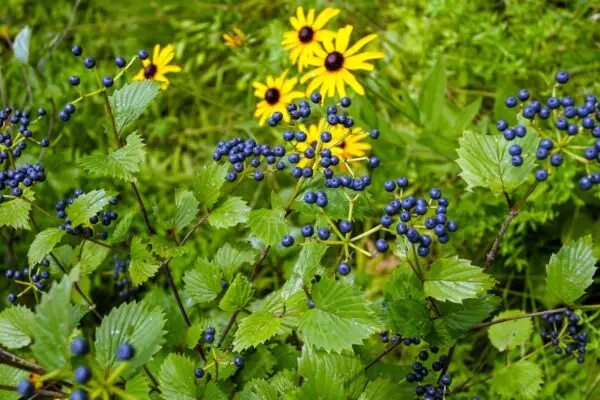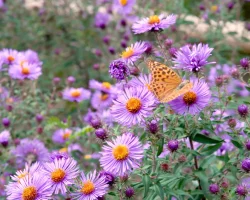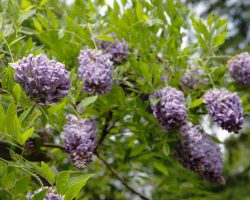Arrowwood viburnum is a native shrub that dramatically changes throughout the year, moving from showy blossoms to glossy leaves to berry-laden branches. It’s a bird magnet. Arrowwood viburnums can become larger shrubs, topping out around 10-15 feet. Plant these along your property line, under taller trees, or against buildings, and watch the birds go wild. Arrowwood viburnums are one of several viburnums native to North America. Discover planting tips and varieties below.

Arrowwood viburnum is one of the many native viburnums found in North America (our Beginner’s Guide to Native Viburnums lists several more.)
Why arrowwood viburnum matters
Arrowwood viburnum is one of the most adaptable, wildlife-supporting shrubs you can plant—and proof that native doesn’t mean boring. Found naturally across much of North America, it’s been thriving here for thousands of years, perfectly tuned to our soil, seasons, and pollinators.
Why plant arrowwood viburnum:
- Wildlife support. Its spring flowers feed pollinators, and its fall berries are beloved by songbirds.
- Low-maintenance beauty. After the first year, all it needs is rain—no fertilizer, no fuss.
- Four-season interest. From lacy white blooms to fiery fall leaves and winter berries, it keeps your garden lively all year.
- Built to last. Native plants like arrowwood have weathered centuries of storms, droughts, and heat—making them as resilient as they are beautiful.
And one more benefit to planting arrowwood viburnum…

Arrowwood viburnum is a host plant for spring azure butterflies
If you need one more reason to plant this easy-going shrub, here it is: arrowwood viburnum is a host plant for spring azure butterflies. A host plant is a specific plant that a bug or butterfly lays its eggs on. Without host plants like arrowwood viburnum, we would not have spring azure butterflies.
We know their name and their native range. Now, let’s focus on how arrowwood viburnums change throughout the year:
Arrowwood viburnums throughout the seasons
These shrubs look fantastic no matter the season.

Spring
In the spring, palm-sized white blossoms are covered with pollinators.

Summer
The flowers slowly turn into berries, while the tree is filled with bright green leaves.

Fall
The leaves turn firey shades of orange and red, and the branches are filled with hungry birds.
Where is arrowwood viburnum native?
Arrowwood viburnum is native to much of the Northeast, Mid-Atlantic, Midwest, and Southern United States.
Where should I plant arrowwood viburnum?
Arrowwood viburnum is an excellent native shrub that some landscapers call indestructible since it thrives with minimal care. Ideas for planting include:
- Front-yard landscaping
- Pollinator gardens
- Hedgerows
- Privacy fences (pair with evergreen natives like mountain laurel, native rhododendrons for maximum coverage)
How to plant arrowwood viburnum
Arrowwood viburnum is a perfect plant for beginner gardeners. It thrives in a wide range of sunlight—from full sun to part shade. Once you’ve found a spot to plant one…
- Choose a location with well-drained soil and full sun to partial shade.
- Dig a hole that is twice as wide as the root ball and just deep enough to accommodate the root ball at the soil level.
- Remove the plant from its container and gently loosen any tangled roots.
- Place the Arrowwood Viburnum in the hole, ensuring that the top of the root ball is level with the surrounding soil.
- Fill the hole with soil, gently tamping it down as you go to remove any air pockets.
- Water the Arrowwood Viburnum thoroughly to settle the soil and hydrate the roots.
How can I find arrowwood viburnum?
Looking to find some for your yard? Here are our recommendations for sourcing:
Where can I find seeds and plants?
Finding native plants can be challenging (we partly blame Marie Antoinette.) To make it easier, we’ve assembled four sourcing ideas.
300+ native nurseries make finding one a breeze
Explore 100+ native-friendly eCommerce sites
Every state and province has a native plant society; find yours
Online Communities
Local Facebook groups are a great plant source
How did arrowwood viburnum get its name?
The plant’s name comes from its history as a useful plant for indigenous people. Arrowwood viburnum is named for its wood, which grows very straight and was used by Native Americans to make arrows. The wood of arrowwood viburnum is strong and flexible, making it ideal for creating arrows for hunting. The wood of the shrub is also durable and is often used for making tool handles and other wooden objects.
What are good arrowwood viburnum pairings?
There are so many fantastic pairings for this native gem. For an incredible fall garden, pair with black-Eyed Susans and asters. If you have a trellis or fence nearby, you’ve got to plant American wisteria or coral honeysuckle. If you’re planting in a part-shade area, heuchera, mountain laurel, and native azaleas are perfect. Or, plant a native dogwood tree and put a garden in the sky.

Pairs well with
To sum it all up: arrowwood viburnum is a perfect shrub to grow in a wide range of environments, especially if you like birds! It changes throughout the seasons, offering lots to enjoy in your landscape. Consider replacing a boring, always-the-same-looking nonnative shrub (like boxwoods) with an Arrowwood Viburnum. The birds will thank you, and you’ll be delighted to watch the show as the seasons change. Meet some other native viburnums in our Beginner’s Guide to Native Viburnums. Happy planting!
Sources
- North Carolina Extension Master Gardeners, Arrowwood Viburnum
- USDA Plants Database, Arrowwood Viburnum
- Lady Bird Johnson Wildflower Center, Southern Arrowwood
Arrowwood Viburnum
Part of our Beginner’s Guide to Native Viburnums
This plant is one of the species featured in our Beginner’s Guide to Native Viburnums.
Head to the complete guide for planting basics, species comparisons, and beginner-friendly tips.
What if your feed was actually good for your mental health?
Give your algorithm a breath of fresh air and follow us.























